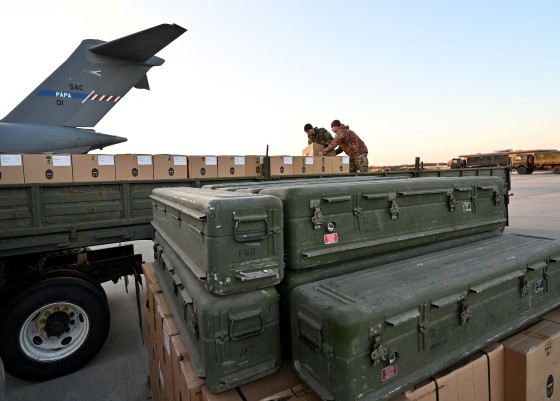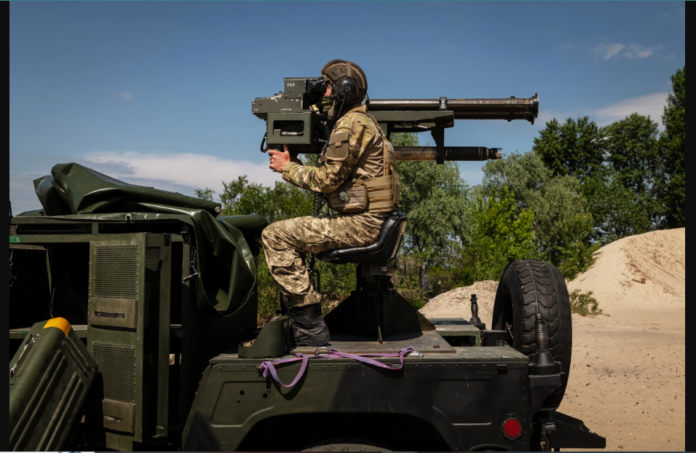Since Russia invaded Ukraine more than a year and a half ago, military industries have had difficulty finding employees, organizing supply chains, and resuming idle manufacturing lines.

Source : NBC news
In Washington Ukraine
The federal government is spending billions of dollars to equip Ukraine and restock American military supplies, but this hasn’t resulted in a substantial increase in employment in the country as defense companies struggle to increase output due to logistical issues.
Although Defense Department officials and weapons manufacturers would not comment on the number of employees hired to help meet the increased demand, remarks made by company executives and corporate filings suggest that, despite the influx of federal dollars, the number of jobs created has been relatively small when compared to the size of the industry as a whole.
Defense industries claim that since Russia invaded Ukraine more than a year and a half ago, they have had difficulty finding workers in a labor market that is tight, untangling supply chain bottlenecks, and restarting manufacturing lines that have been put on hold. Although there are encouraging signals, industry experts believe it may take many more years before output peaks and the billions of dollars allocated for the Ukrainian conflict start to have an effect on the overall economy.
Cynthia Cook, the head of the Defense-Industrial Initiatives Group at the Center for Strategic and International Studies, a nonpartisan think tank, said that “it takes time to surge.” “There isn’t much manufacturing slack in the system because the industrial base is incentivized to be as efficient as possible, which makes it challenging to grow.”
For the conflict in Ukraine, the United States has provided about $44 billion in direct security aid, the most of which is used to restock American arsenals with guns, ammunition, and other supplies that are sent to the front lines. Last week, President Joe Biden said that he was looking for an extra $61.4 billion in funding for Israel and $14.3 billion for Ukraine.
Republicans in Congress have been pushing to stop funding for Ukraine, even threatening to shut down the government in order to stop funding. During his week-long campaign to win over voters, Biden claimed that the funding would have both domestic and international benefits.
During his broadcast speech from the Oval Office, Biden said, “We use the money allocated by Congress to replenish our own stores and our own stockpiles with new equipment, equipment that defends America and is made in America.” “Artillery shells manufactured in 12 states across the country, including Pennsylvania, Ohio, Texas, and so much more,” as well as Patriot missiles for air defense batteries created in Arizona
However, increasing output in such locations takes time. Some businesses are being forced to reconstruct production lines and rehire employees in order to resume the manufacture of weapons they haven’t produced in years. Others said they have had trouble hiring, especially those qualified to get security clearances or prepared to relocate to more isolated locations where the manufacture of weapons is customarily carried out. There are situations when it becomes necessary to build new facilities, a process that may take many years to complete, including the planning, permitting, and approval phases.
William LaPlante, the undersecretary of defense for acquisition and sustainment at the Defense Department, stated during a conference last month that the United States has fallen into a cycle of spiking then shutting down its defense manufacturing capabilities in recent decades due to the short-term horizon for certain types of defense spending. Because of this, when a dispute emerges and demand spikes, it may take a number of years for businesses to relaunch their production infrastructure, according to LaPlante.
You can accomplish a lot if the government and business work together with concentration. You can and we are increasing our manufacturing lines,” LaPlante said. “But it’s that simple—you get the industrial base that you resource,”
Formerly known as Raytheon, RTX Corp. has stated that it is finding it more difficult to meet demand for its weapons, such as those being used in the conflict in Ukraine, due to supply chain disruptions, difficulty hiring engineers, skilled laborers, and security clearance holders, as well as high turnover and rising wages.
“We’ve had trouble getting the raw materials, components, and other supplies we need, as well as services, either in a timely manner or at all. In its financial report, which was made public on October 24, the firm said, “We have also had trouble hiring qualified personnel, particularly personnel with specialized engineering experience and security clearances.” “We don’t know when our labor and supply chain issues will get better; it depends on a lot of variables and what happens in the future.”
Since the United States hadn’t placed an order for a Stinger missile in roughly 18 years, the company informed investors last spring that it would take more than a year to increase production of the missiles, which have become popular weapons in Ukraine. As a result, the company had a limited supply of materials and had to redesign some of the electronics in order to replace parts that were no longer available.
“Building capacity will be challenging, and sustained attention from the top will be necessary to get it going,” Cook said. “The most efficient contractor usually wins since defense firms are usually handed contracts at a low cost basis. This indicates that the system has little production slack, which makes growth difficult.
During this week’s earnings call, Raytheon CEO Greg Hayes informed investors that the company has received $3 billion in orders for restocking U.S. stocks with equipment sent to Ukraine and anticipates receiving an additional $4 billion in orders over the next two years. However, it will take another three to six months to fulfill those commitments.
According to Hayes, “you won’t see a big revenue pop, even next year from this.”
According to Lockheed Martin, the conflict in Ukraine has resulted in a rise in demand for its goods, which include launchers for the High Mobility Artillery Rocket System and Javelin anti-tank missiles. However, the firm said that because of the “long-cycle nature of our business and current industry capacity,” the effect on its operations would be seen over years rather than months, and it does not expect a major boost in sales in 2023.
In 2022, Lockheed added 2,000 employees to its workforce across all of its divisions, representing a decrease of less than 2% for the whole organization. According to a Lockheed representative, the corporation is now hiring for 900 positions in its fire control and missile divisions. There are forty job vacancies at Lockheed, which produces missile systems used in Ukraine in Camden, Arkansas, the business said.
The Combat Systems business section of General Dynamics, which manufactures tanks and munitions, said that orders were at their highest point in years. The firm attributed this to increases in vehicle and tank sales as well as initiatives to increase the country’s ability to produce artillery.
According to a General Dynamics spokesman, the business doesn’t keep track of newly additional positions that are specifically connected to Ukraine. In 2022, General Dynamics hired 3,400 new employees worldwide, bringing its total employment to 106,500. The business is constructing a new facility in Mesquite, Texas, which will ultimately house 125 employees and produce artillery round casings, which have been in high demand ever since Russia invaded Ukraine.
Brad Martin, director of the RAND Corporation’s Institute for Supply Chain Security, stated that often, corporations would add a shift after forcing employees to work overtime. However, in the long run, we’re really talking about adding additional factories, which will essentially be located in the same locations as they are already created. All of that will ultimately have a big impact on the local economy.
Due to the Ukrainians’ daily firing of thousands of rounds, ammunition has been in high demand.
An Army official said that the Defense Department intends to utilize $2 billion from the Ukraine supplemental budget packages to expand manufacture of weapons and ammunition used in Ukraine at facilities in Pennsylvania, Iowa, Tennessee, and Virginia. The number of employment that such investments potentially produce was not disclosed by the Army. There are 26 available vacancies at one munitions mill in Middletown, Iowa, according to the outside employment agency’s website.
The Defense Department expects to further triple that output to 100,000 per month by 2025 with the expenditures it is making at its facilities, according to LaPlante. The production of 155 millimeter artillery rounds used in huge towed guns has increased over the last year.
It will still be up for debate whether manufacturing can continue to grow at that rate or whether the country will see further booms and busts.
Our industrial base is still severely constrained, mostly due to manufacturing capacity. We continue to face the same types of obstacles that we had over the last several years, so I don’t think it’s changed much that much,” Martin said. “I think there’s more awareness, but to really get us into a better place, it will take some persistent funding and time.”





